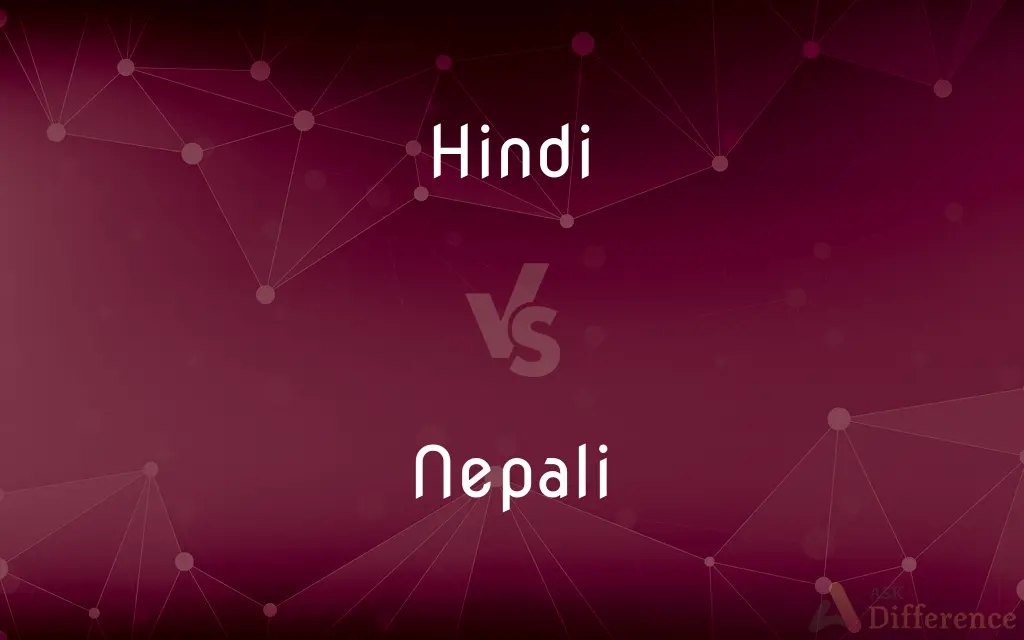Hindi vs. Nepali — What's the Difference?
By Tayyaba Rehman — Updated on September 30, 2023
Hindi is the official language of India, primarily spoken in Northern India, using Devanagari script. Nepali, the official language of Nepal, also uses Devanagari script but has distinct grammar and vocabulary.

Difference Between Hindi and Nepali
Table of Contents
ADVERTISEMENT
Key Differences
Hindi and Nepali are distinct languages that belong to the Indo-Aryan group of the Indo-European language family. Hindi, widely spoken in India, is enriched by multiple dialects and receives significant influence from Sanskrit, showcasing a rich variety of forms. In contrast, Nepali, as the official language of Nepal, maintains its uniqueness through its own set of dialects and vocabulary, exhibiting distinct linguistic features and influences.
While Hindi is predominantly spoken in Northern India and serves as the lingua franca of the Indian subcontinent, it has numerous dialects and variations reflecting the diverse culture of the region. Conversely, Nepali, spoken primarily in Nepal, reflects the cultural amalgamation of the Himalayan region and displays distinctive phonological, morphological, and syntactical structures, embedding the ethos of its native land.
Both Hindi and Nepali utilize the Devanagari script, but they exhibit differences in pronunciation, grammar, and vocabulary. Hindi possesses a rich array of phonetic sounds and extensive vocabulary, catering to the diverse communicative needs of its speakers. On the other hand, Nepali has its unique set of sounds and words, mirroring the socio-cultural and geographical environment of Nepal, with influences from Tibetan and other Sino-Tibetan languages.
Hindi, with its extensive literature and media presence, plays a pivotal role in the cultural and intellectual life of India, shaping societal norms and values. In contrast, Nepali, with its rich literary tradition and media landscape, represents the cultural heritage and intellectual currents of Nepal, contributing to the national identity and collective consciousness of the Nepali people.
In conclusion, Hindi and Nepali, although sharing the same script and some linguistic features due to their common Indo-Aryan roots, are separate languages with distinct grammatical rules, phonetics, and vocabularies, each encapsulating the rich cultural tapestry and historical legacy of their respective regions.
ADVERTISEMENT
Comparison Chart
Geographic Origin
Predominantly spoken in Northern India.
Official language of Nepal.
Script
Uses the Devanagari script.
Also uses the Devanagari script.
Influences
Has significant influence from Sanskrit.
Exhibits influences from Tibetan and other Sino-Tibetan languages.
Dialects and Variations
Enriched by multiple dialects and variations reflecting the diverse culture of India.
Maintains its uniqueness through its own set of dialects and vocabulary.
Literature and Media
Possesses extensive literature and has a substantial presence in media, reflecting Indian culture.
Rich in literature and media, representing the cultural heritage of Nepal.
Compare with Definitions
Hindi
A language that serves as a lingua franca across various states in India.
Hindi acts as a bridge, fostering communication among people from different linguistic backgrounds in India.
Nepali
The official and predominant language of Nepal, belonging to the Indo-Aryan language family.
Nepali is integral to the cultural identity and national unity of Nepal.
Hindi
The official language of the Indian government, used for administrative purposes.
Official documents in India are often drafted in both English and Hindi.
Nepali
A language with a rich literary tradition, representing the intellectual currents of Nepal.
Nepali literature, with its varied genres, offers insights into the philosophical and cultural heritage of Nepal.
Hindi
A prominent language of the Indo-Aryan group, primarily spoken in Northern India.
Hindi, with its diverse dialects, is a reflection of India’s rich cultural mosaic.
Nepali
A language using the Devanagari script with distinctive phonological and grammatical structures.
Learning Nepali involves mastering unique sounds and grammatical rules distinct from other Indo-Aryan languages.
Hindi
A language known for its rich tradition of poetry, prose, and music.
Bollywood songs predominantly use Hindi lyrics, blending traditional and modern musical elements.
Nepali
A language enriched by its own set of dialects and vocabulary, reflecting Nepal’s diverse cultures.
The diversity in Nepali dialects mirrors the rich cultural tapestry of the Himalayan region.
Hindi
Hindi (Devanagari: हिन्दी, IAST/ISO 15919: Hindī), or more precisely Modern Standard Hindi (Devanagari: मानक हिन्दी, IAST/ISO 15919: Mānak Hindī), is an Indo-Aryan language spoken chiefly in India. Hindi has been described as a standardised and Sanskritised register of the Hindustani language, which itself is based primarily on the Khariboli dialect of Delhi and neighbouring areas of Northern India.
Nepali
A language exhibiting influences from Tibetan and other Sino-Tibetan languages.
The lexical similarities between Nepali and Tibetan languages underline the cross-cultural interactions in the Himalayan region.
Hindi
An Indic language of northern India, derived from Sanskrit and written in the Devanagari script. It is the fourth most widely spoken language in the world, with more than 250 million people speaking it as their first language.
Nepali
Of or relating to Nepal or its people, language, or culture.
Hindi
Relating to Hindi.
Nepali
A native or inhabitant of Nepal.
Hindi
A group of vernacular Indic dialects spoken in northern India.
Nepali
A person of Nepali ancestry.
Hindi
The literary and official language of northern India that is based on these dialects. It is written in Devanagari and uses Sanskrit as a resource language.
Nepali
The Indic language of Nepal, closely related to Hindi.
Hindi
The name given by Europeans to that form of the Hindustani language which is chiefly spoken by native Hindus. In employs the Devanagari character, in which Sanskrit is written.
Nepali
Same as Nepalese.
Hindi
The most widely spoken of modern Indic vernaculars; spoken mostly in the north of India; along with English it is the official language of India; usually written in Devanagari script
Nepali
A native or inhabitant of Nepal
Hindi
Of or relating to or supporting Hinduism;
The Hindu faith
Nepali
The official state language of Nepal
Hindi
A language using the Devanagari script and enriched with Sanskrit vocabulary.
Hindi literature is replete with works that extensively employ Sanskrit-derived words.
Nepali
Of or pertaining to or characteristic of Nepal or its people or language or culture;
Nepalese troops massed at the border
Nepali mountains are among the highest in the world
The different Nepali words for `rice'
Common Curiosities
Is Hindi primarily spoken in Northern India?
Yes, Hindi is predominantly spoken in Northern India.
Is Nepali the official language of Nepal?
Yes, Nepali is the official language of Nepal.
Share Your Discovery

Previous Comparison
Devotion vs. Worship
Next Comparison
Resistant vs. ResistiveAuthor Spotlight
Written by
Tayyaba RehmanTayyaba Rehman is a distinguished writer, currently serving as a primary contributor to askdifference.com. As a researcher in semantics and etymology, Tayyaba's passion for the complexity of languages and their distinctions has found a perfect home on the platform. Tayyaba delves into the intricacies of language, distinguishing between commonly confused words and phrases, thereby providing clarity for readers worldwide.
















































